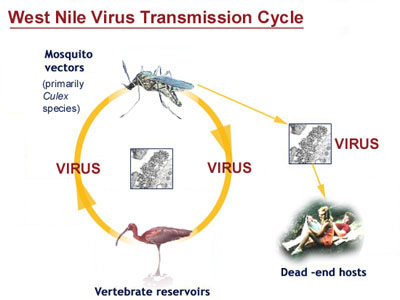|
||||||

|

|
||||||||||
| West Nile Virus | |||||||||||
| The Bug | Disease | Prevention | Links | |||||||||||
The Bug
What is it?
|
|||||||||||
Where is it found?
The first isolate of the West Nile virus came from the blood of a febrile woman in the West Nile district of Uganda in 1937. The virus has subsequently been isolated in Africa, Asia, southern Europe and the former USSR. Encephalitis outbreaks caused by the West Nile virus have occurred in Algeria, Azerbaijan, Central African Republic, Democratic Republic of Congo, Egypt, Ethiopia, India, Madagascar, Nigeria, Pakistan, Senegal, Sudan, and in a few European countries. The most recent outbreak occurred in Bucharest, Romania, in 1996.
The West Nile virus and other arboviral (transmitted by insect vectors) encephalitides are found across the globe. Only four viruses, however, have been known to cause encephalitis in the USA: eastern equine encephalitis (EEE), western equine encephalitis (WEE), St. Louis encephalitis (SLE) and LaCrosse (LAC) encephalitis. All of these viruses are transmitted by mosquitoes during the summer months (June-September).
Until the New York city outbreak, the West Nile virus had never been
found in the Western Hemisphere before. It is unclear how the virus arrived
in the U.S.
How is it transmitted?
The West Nile virus is an arborvirus (arthropod-borne virus), transmitted between hosts via a blood-feeding insect (called the virus vector). The primary hosts of the West Nile virus are wild birds, and the primary vectors are bird-feeding mosquitoes, mainly of the Culex species. These organisms are vital for the virus’ transmission cycle: birds provide an environment in which the virus can replicate at high levels – high enough that blood picked up by mosquitoes contains virus particles. The mosquitoes are needed for the spread of the virus particles to new hosts.
In some cases, animals other than the primary hosts may become infected with the virus. The West Nile virus, for example, can also infect humans. These alternative hosts are often referred to as “dead end” hosts, as they are not part of the virus’ normal transmission cycle. These organisms do not usually produce enough virus particles to allow them to become a reservoir for the virus. The infection thus reaches a dead end in this host.
 Mosquitoes are usually the primary vectors for transmission of the West
Nile virus. In Africa and Asia, however, ticks have been found carrying
the virus.
Mosquitoes are usually the primary vectors for transmission of the West
Nile virus. In Africa and Asia, however, ticks have been found carrying
the virus.
West Nile virus is only spread via its insect vector; it is NOT transmitted person-to-person or bird-to-person.
In warmer climates, the virus can be found year-round. In temperate climates, the virus usually occurs in late summer or early fall (ie – in peak mosquito season). It is not known how the virus returns at the end of the cold season, although there are a few theories:
The virus may:
- survive in hibernating Culex mosquitoes
- be transmitted to offspring by infected female Culex mosquitoes
- establish a chronic infection in its hosts
- get reintroduced each spring by chronically infected migratory birds.
What disease(s) does it cause?
West Nile virus causes viral encephalitis; an infection of the central nervous system (CNS) which involves inflammation of the brain.
West Nile virus causes an infection similar to the St. Louis encephalitis,
but with milder symptoms. In most cases, the infection is asymptomatic
or causes mild flu-like symptoms.
Who/what is at risk of infection?
 In general, wild birds are the primary hosts of the West Nile virus. Birds
do not normally show any signs of infection – they merely act as a reservoir
for virus replication. On occasion, however, humans can also become infected
with the virus. Any person living in an area where there are infected
(virus-carrying) mosquitoes are at risk of getting bitten. However, not
everyone who is bitten by an infected mosquito will develop West Nile
encephalitis. In fact, most cases are very mild; with flu-like symptoms
or no symptoms at all.
In general, wild birds are the primary hosts of the West Nile virus. Birds
do not normally show any signs of infection – they merely act as a reservoir
for virus replication. On occasion, however, humans can also become infected
with the virus. Any person living in an area where there are infected
(virus-carrying) mosquitoes are at risk of getting bitten. However, not
everyone who is bitten by an infected mosquito will develop West Nile
encephalitis. In fact, most cases are very mild; with flu-like symptoms
or no symptoms at all.
At risk are:
- the very young
- individuals >50 years of age
- individuals with weakened immune systems
- individuals with other medical conditions, including
diabetes, heart disease, or individuals on dialysis.
|
|
|||
|
© Copyright 1999-2007 Department of Microbiology, Mount Sinai Hospital, Toronto, Canada. All rights reserved.
All rights reserved. Last Modified |
|||


